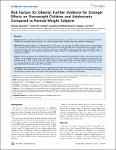Risk Factors for Obesity: Further Evidence for Stronger Effects on Overweight Children and Adolescents Compared to Normal-Weight Subjects
Beyerlein, Andreas
Toschke, André Michael
Rosario, Angelika Schaffrath
Kries, Rüdiger von
Background: We recently showed that in preschoolers risk factors for overweight show stronger associations with BMI in children with high BMI values. However, it is unclear whether these findings might also pertain to adolescents. Methods: We extracted data on 3–10 year-old (n = 7,237) and 11–17 year-old (n = 5,986) children from a representative cross-sectional German health survey (KiGGS) conducted between 2003 and 2006 and calculated quantile regression models for each age group. We used z-scores of children’s body mass index (BMI) as outcome variable and maternal BMI, maternal smoking in pregnancy, low parental socioeconomic status, exclusive formula-feeding and high TV viewing time as explanatory variables. Results: In both age groups, the estimated effects of all risk factors except formula-feeding on BMI z-score were greatest for children with the highest BMI z-score. The median BMI z-score of 11–17 year-old children with high TV viewing time, for example, was 0.11 [95% CI: 0.03, 0.19] units higher than the median BMI z-score of teenage children with low TV viewing time. This risk factor was associated with an average difference of 0.18 [0.06, 0.30] units at the 90th percentile of BMI z-score and of 0.20 [0.07, 0.33] units at the 97th percentile. Conclusions: We confirmed that risk factors for childhood overweight are associated with greater shifts in the upper parts of the children’s BMI distribution than in the middle and lower parts. These findings pertain also to teenagers and might possibly help to explain the secular shift in the upper BMI percentiles in children and adolescents.
No license information

